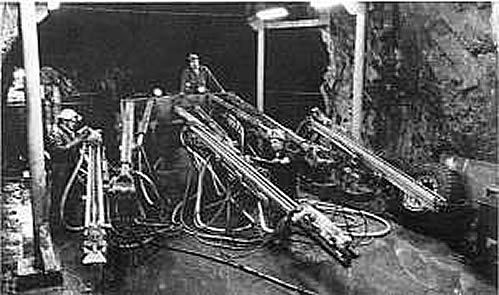Granduc Mine

ENGINEERING AND PLANNING - Continued
Photo - 7 boom jumbo in repair shop underground
The other major aspect studied at this time was the feasibility of trans- verse and/ or longitudinal sub-level caving. In the narrower sections of the ore zone, up to a 50-ft. width, the longitudinal method was used and those sections exceeding that thickness woulds be mined by the transverse method. Crosscuts 11 ft. by 16 ft. are driven on 30-ft. horizontal intervals and a 3% slope was maintained to assure drainage. On the retreat from the hangingwall, a diamond-shape zone resulting from the staggering of the crosscuts would be blasted from each crosscut.
Underground repair shop showing mechanics working on a three-drill jumbo.In those ore zones less than 50 feet in thickness the longitudinal method was being used to minimize waste. The longitudinal workings were driven along the footwall on 60-ft. vertical spacing, the headings being advanced to the end of the orebody and the ore extracted on retreat.
The blastholes are 2-1/8 in. in diameter and are drilled upward in a standard ring pattern using six Gardner- Denver two-boom "Fan-DriI" Mark-1 and Mark 2 jumbos. Maximum hole length is 60 feet in the transverse areas and 80 feet in the longitudinal zones. In addition, seven three-boom Mark 3 jumbos by the same manufacturer are being used in development work.
The holes are loaded with I Y2-in. by 16-in. Cilgel "B", 70%; Forcite Xactex was used for perimeter blasting. The ex- plosives are inserted into plastic liners. Major mine access to the working levels between the 2,600 and 3, 720 levels is by a ramp system. Studies of the alternative methods of access indicated the economic advantages of the ramp layouts, although at the time no known project, mining a steeply- dipping orebody, operated solely with a ramp system. It was noted during the visit to Sweden that the mines at Kiruna and Malmberget operated their ramps in conjunction with a shaft.
ENGINEERING-CONTINUED